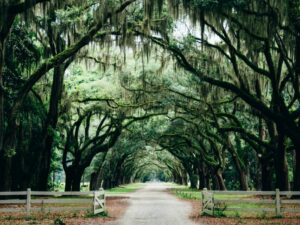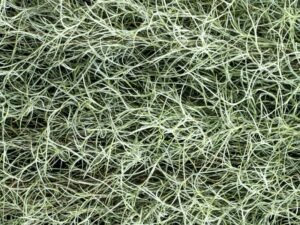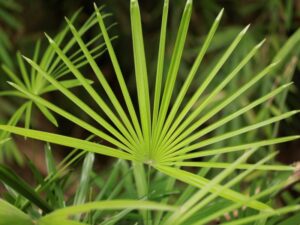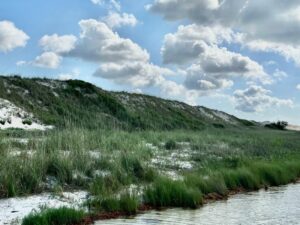Something we focus on a lot here at Crab Island Watersports is acknowledging and showing our appreciation for nature – it is, after all, what allows us to offer our great services. We do our best to educate you on the wonderful native plants around our region and all the protected areas in which you can discover them.
Now, while it is true that the shimmering emerald waters from Panama City Beach to Destin are what most will associate with the Gulf Coast of Florida, it’s the lush diversity of flora that truly decorate and support its precious ecosystem. Without this diversity, not only the habitat on which local wildlife depends, but also the entire landscape would appear dramatically different.
Plants here have the capability to thrive in saline environments and are not only greatly influenced by their proximity to the coast, but also by the coastal dunes, salt marshes, and pine forests that also surround our beautiful coastline. In various regions around the world, there are special examples of local vegetation that are so intertwined within the culture, that we cannot picture one without the other: Maple trees in Canada, tulips in the Netherlands, redwoods in California. Let’s look at some of the truly iconic plant life seen around Destin and its surrounding areas, you won’t want to miss them!
Plant species that are not native to Florida are said to be “naturalized”, referring to plants that did not originate in Florida, but however they got there, they now grow on their own and established habitat. Many naturalized plants can be invasive to Florida’s native plants as they interrupt the natural ecosystem processes, especially those that grow profusely. In addition to “naturalized” plants, it is also common to find “non-native” or “alien” plants, which are species that are not naturally occurring in Florida but rather have been intentionally or accidentally introduced to the landscape.
Florida has a massive array of native plants, and because of the resilience and adaptability of many of these species, the Florida Native Plant Society indicates that it is favorable to introduce native plants to our home gardens. These plants often flourish on their own, with little-to-no human intervention required, making them ideal in every way for the home gardener.
Between their unique and funky names, quirky characteristics and beautiful vibrant colors, the Sunshine States’ native plant life is fascinating and ideal for any plant lovers to learn about. Here are some of our favorite native Florida plants!:
Live Oak (Quercus virginiana)

This colorful shrub grows everywhere in Florida. Its fantasy-grape-colored small balls make it very recognizable. The little purple fruits grow on each branch from late summer to early fall. This plant requires full to partial sun exposure and preferably nutrient-rich soils with presence of organic matter; it can however tolerate sandy soils.
Species name: Callicarpa Americana
Spanish Moss (tillandsia usneoides)

Almost synonymous with the stunning live oak trees along the coast are its beautiful cohabitant, spanish moss. These wispy grey plants ask nothing from its tall friends, but a sturdy place to stretch out. Instead, the tentacle-like stems gather all its nourishment from the air around it. Interestingly, it is closely related to pineapples and is indigenous to continental United States. Native wildlife absolutely depends on it, making use of the foliage to hide from predators or for resting sites to recover, as well as building nests and materials from it to hold eggs. Historically, it was truly treasured in its use as fibre for the stuffing of furniture upholstery and mattresses, though now is rarely only used by artisans or local craftsmen and you may even find a few relics in some of our local stores. Nevertheless, it continues to drape itself along tree branches, adding even more character to live oak trees and is one of the most recognizable floral features that make up these parts of our state.
Saw Palmetto (Sereno repens)

We’ve all seen these small, shrub-like palms with their distinctive long and fan-shaped leaves. They adorn the entire region around the Gulf coast but especially around here. Running your finger lengthways up the leaves, you soon realise where they get their name from, their serrated edges quick to cut through your skin or clothing. But despite their teeth, saw palmetto has been used for centuries by early Native Americans and even up until today for a range of natural healing and remedies. Endemic to the south-eastern United States, they provide a crucial source of food for native wildlife, in particular their berries. Black bears, deer and birds feast on the berries and honeybees on their flowers, while the plant’s dense thickets provide cover for a variety of small mammals, including raccoons, opossums, and rabbits. Just like other locally seen plants, they’re tough and salt resistant, and can survive even the harshest conditions. There are some shrubs that have been soaking up sun around Florida for hundreds of years and are still going strong! Truly iconic.
Sea Oats (Uniola paniculate)

Of all the plants that make up our coastal community, it can be easy to overlook this particular one. It doesn’t produce vibrant flowers to catch your attention, nor does it grow tall enough to provide you with a shady place to rest. But despite this, our precious coastline, especially our sand dunes, would appear almost naked without the humble sea oats. They grow an enormous root system, which during extreme weather events, such as hurricanes and tropical storms, help contain sand dunes and protect the shoreline. They withstand a lot of the harsh conditions that come with a coastal habitat. Heavy bombardment from strong winds, sand and salt spray are no match for this coast guard. Capable of catching blowing sand, it engineers surrounding dunes and slowly builds and supports an entire ecosystem. By helping to prevent erosion along the Emerald coast, sea oats are able to preserve our beautiful communities so that we may enjoy them for generations to come.
We could certainly keep going but better yet, why not come and explore Destin and uncover more of its beauty with your own eyes. Take a walk around and you’ll soon recognise all the stunning nature we have to offer. Don’t forget to check our website for more interesting information about Destin and its surrounding areas, we’re adding more content every month!